Inhibitory Effects of Carrageenans on Endotoxin-Induced Inflammation
Abstract
1. Introduction
2. Results
2.1. Carrageenans
2.2. Atomic Force Microscopy of LPS and LPS–GRG Mixtures
2.3. Effect of LPS and CRGs on the Production of Cytokines by Human Cells
2.4. Effect of CRGs on Stress Reaction of Mice Induced with E. coli LPS
2.5. The Effects of Food Supplement Carrageenan-FE on the Immune System and Hemostasis Parameters in Patients with Food Borne Toxicoinfection
3. Discussion
4. Materials and Methods
4.1. Polysaccharides
4.2. Atomic Force Microscopy (AFM)
4.3. IL-10 and TNF-α Inducing Activity on the Human Blood Cells
4.4. Animals and Diets
4.5. Experimental Design
4.6. Medico-Biological Study of Food Supplement Carrageenan-FE
4.7. Statistical Analysis
5. Conclusions
Author Contributions
Funding
Conflicts of Interest
References
- Fuke, N.; Nagata, N.; Suganuma, H.; Ota, T. Regulation of gut microbiota and metabolic endotoxemia with dietary factors. Nutrients 2019, 11, 2277. [Google Scholar] [CrossRef]
- Chang, S.; Li-Wu, L. Training Effects of Different Approaching Steps on Overarm Throwing Performance for Boys Aged 7–12 Years. Sport. Exerc. Res. 2010, 12, 191–209. [Google Scholar]
- Kiechl, S.; Egger, G.; Mayr, M.; Wiedermann, C.J.; Bonora, E.; Oberhollenzer, F.; Muggeo, M.; Xu, Q.; Wick, G.; Poewe, W.; et al. Chronic Infections and the Risk of Carotid Atherosclerosis. Circulation 2001, 103, 1064–1070. [Google Scholar] [CrossRef]
- Lugtenberg, B.; Van Alphen, L. Molecular architecture and functioning of the outer membrane of Escherichia coli and other gram-negative bacteria. Biochim. Biophys. Acta—Rev. Biomembr. 1983, 737, 51–115. [Google Scholar] [CrossRef]
- Stoll, L.L.; Denning, G.M.; Weintraub, N.L. Potential Role of Endotoxin as a Proinflammatory Mediator of Atherosclerosis. Arterioscler. Thromb. Vasc. Biol. 2004, 24, 2227–2236. [Google Scholar] [CrossRef] [PubMed]
- Rietschel, E.T.; Brade, H.; Holst, O.; Brade, L.; Müller-Loennies, S.; Mamat, U.; Zähringer, U.; Beckmann, F.; Seydel, U.; Brandenburg, K.; et al. Bacterial Endotoxin: Chemical Constitution, Biological Recognition, Host Response, and Immunological Detoxification. In Pathology of Septic Shock; Springer: Berlin/Heidelberg, Germany, 1996; pp. 39–81. ISBN 978-3-642-80186-0. [Google Scholar]
- Hassoun, H.T.; Kone, B.C.; Mercer, D.W.; Moody, F.G.; Weisbrodt, N.W.; Moore, F.A. Post-injury multiple organ failure: The role of the gut. Shock 2001, 15, 1–10. [Google Scholar] [CrossRef] [PubMed]
- Lee, S.H. Intestinal Permeability Regulation by Tight Junction: Implication on Inflammatory Bowel Diseases. Intest. Res. 2015, 13, 11. [Google Scholar] [CrossRef] [PubMed]
- Cani, P.D.; Amar, J.; Iglesias, M.A.; Poggi, M.; Knauf, C.; Bastelica, D.; Neyrinck, A.M.; Fava, F.; Tuohy, K.M.; Chabo, C.; et al. Metabolic Endotoxemia Initiates Obesity and Insulin Resistance. Diabetes 2007, 56, 1761–1772. [Google Scholar] [CrossRef]
- Cani, P.D.; Bibiloni, R.; Knauf, C.; Waget, A.; Neyrinck, A.M.; Delzenne, N.M.; Burcelin, R. Changes in Gut Microbiota Control Metabolic Endotoxemia-Induced Inflammation in High-Fat Diet-Induced Obesity and Diabetes in Mice. Diabetes 2008, 57, 1470–1481. [Google Scholar] [CrossRef]
- Gomes, J.M.G.; de Assis Costa, J.; de Alfenas, R.C.G. Metabolic endotoxemia and diabetes mellitus: A systematic review. Metabolism 2017, 68, 133–144. [Google Scholar] [CrossRef]
- Brown, B.I. Nutritional Management of Metabolic Endotoxemia: A Clinical Review. Altern. Ther. Health Med. 2017, 23, 42–54. [Google Scholar] [PubMed]
- Estruch, R.; Martinez-Gonzalez, M.A.; Corella, D.; Basora-Gallisa, J.; Ruiz-Gutierrez, V.; Covas, M.I.; Fiol, M.; Gomez-Gracia, E.; Lopez-Sabater, M.C.; Escoda, R.; et al. Effects of dietary fibre intake on risk factors for cardiovascular disease in subjects at high risk. J. Epidemiol. Commun. Heal. 2009, 63, 582–588. [Google Scholar] [CrossRef] [PubMed]
- Lahaye, M.; Kaeffer, B. Seaweed dietary fibres: Structure, physico-chemical and biological properties relevant to intestinal physiology. Sci. Aliments 1997, 17, 563–5834. [Google Scholar]
- Knutsen, S.H.; Myslabodski, D.E.; Larsen, B.; Usov, A.I. A Modified System of Nomenclature for Red Algal Galactans. Bot. Mar. 1994, 37, 163–169. [Google Scholar] [CrossRef]
- Yermak, I.M.; Khotimchenko, Y.S. Chemical properties, biological activities and applications of carrageenan from red algae. Recent Adv. Mar. Biotechnol. 2003, 9, 207–255. [Google Scholar]
- Winter, C.A.; Risley, E.A.; Nuss, G.W. Carrageenin-Induced Edema in Hind Paw of the Rat as an Assay for Antiinflammatory Drugs. Exp. Biol. Med. 1962, 111, 544–547. [Google Scholar] [CrossRef]
- Huang, M.-H.; Wang, B.-S.; Chiu, C.-S.; Amagaya, S.; Hsieh, W.-T.; Huang, S.-S.; Shie, P.-H.; Huang, G.-J. Antioxidant, antinociceptive, and anti-inflammatory activities of Xanthii Fructus extract. J. Ethnopharmacol. 2011, 135, 545–552. [Google Scholar] [CrossRef]
- Ghosh, T.; Chattopadhyay, K.; Marschall, M.; Karmakar, P.; Mandal, P.; Ray, B. Focus on antivirally active sulfated polysaccharides: From structure–activity analysis to clinical evaluation. Glycobiology 2009, 19, 2–15. [Google Scholar] [CrossRef]
- Pereira, M.G.; Benevides, N.M.B.; Melo, M.R.S.; Valente, A.P.; Melo, F.R.; Mourão, P.A.S. Structure and anticoagulant activity of a sulfated galactan from the red alga, Gelidium crinale. Is there a specific structural requirement for the anticoagulant action? Carbohydr. Res. 2005, 340, 2015–2023. [Google Scholar] [CrossRef]
- Zúñiga, E.A.; Matsuhiro, B.; Mejías, E. Preparation of a low-molecular weight fraction by free radical depolymerization of the sulfated galactan from Schizymenia binderi (Gigartinales, Rhodophyta) and its anticoagulant activity. Carbohydr. Polym. 2006, 66, 208–215. [Google Scholar] [CrossRef]
- Yermak, I.M.; Barabanova, A.O.; Aminin, D.L.; Davydova, V.N.; Sokolova, E.V.; Solov’eva, T.F.; Kim, Y.H.; Shin, K.S. Effects of structural peculiarities of carrageenans on their immunomodulatory and anticoagulant activities. Carbohydr. Polym. 2012, 87, 713–720. [Google Scholar] [CrossRef]
- Cohen, S.M.; Ito, N. A Critical Review of the Toxicological Effects of Carrageenan and Processed Eucheuma Seaweed on the Gastrointestinal Tract. Crit. Rev. Toxicol. 2002, 32, 413–444. [Google Scholar] [CrossRef] [PubMed]
- Weiner, M.L. Food additive carrageenan: Part II: A critical review of carrageenan in vivo safety studies. Crit. Rev. Toxicol. 2014, 44, 244–269. [Google Scholar] [CrossRef] [PubMed]
- Zhu, Z.; Zhu, B.; Sun, Y.; Ai, C.; Wang, L.; Wen, C.; Yang, J.; Song, S.; Liu, X. Sulfated Polysaccharide from Sea Cucumber and its Depolymerized Derivative Prevent Obesity in Association with Modification of Gut Microbiota in High-Fat Diet-Fed Mice. Mol. Nutr. Food Res. 2018, 62, 1800446. [Google Scholar] [CrossRef] [PubMed]
- Hu, S.; Wang, J.; Xu, Y.; Yang, H.; Wang, J.; Xue, C.; Yan, X.; Su, L. Anti-inflammation effects of fucosylated chondroitin sulphate from Acaudina molpadioides by altering gut microbiota in obese mice. Food Funct. 2019, 10, 1736–1746. [Google Scholar] [CrossRef]
- Tateda, K.; Irifune, K.; Shimoguchi, K.; Tomono, K.; Matsumoto, T.; Kaku, M.; Yamaguchi, K.; Hirakata, Y. Potential Activity of Carrageenan to Enhance Antibacterial Host-Defense Systems in Mice. J. Infect. Chemother. 1995, 1, 59–63. [Google Scholar] [CrossRef]
- Fujiki, K.; Shin, D.H.; Nakao, M.; Yano, T. Protective effect of κ-carrageenan against bacterial infections in carp Cyprinus carpio. J. Fac. Agric. Kyushu Univ. 1997, 42, 113–119. [Google Scholar]
- Cheng, A.-C.; Chen, Y.-Y.; Chen, J.-C. Dietary administration of sodium alginate and κ-carrageenan enhances the innate immune response of brown-marbled grouper Epinephelus fuscoguttatus and its resistance against Vibrio alginolyticus. Vet. Immunol. Immunopathol. 2008, 121, 206–215. [Google Scholar] [CrossRef]
- Yeh, S.-T.; Chen, J.-C. Immunomodulation by carrageenans in the white shrimp Litopenaeus vannamei and its resistance against Vibrio alginolyticus. Aquaculture 2008, 276, 22–28. [Google Scholar] [CrossRef]
- Ermak, I.M.; Barabanova, A.O.; Kukarskikh, T.A.; Solovyova, T.F.; Bogdanovich, R.N.; Polyakova, A.M.; Astrina, O.P.; Maleyev, V.V. Natural polysaccharide carrageenan inhibits toxic effect of gram-negative bacterial endotoxins. Bull. Exp. Biol. Med. 2006, 141, 230–232. [Google Scholar] [CrossRef]
- Arabski, M.; Barabanova, A.; Gałczyńska, K.; Węgierek-Ciuk, A.; Dzidowska, K.; Augustyniak, D.; Drulis-Kawa, Z.; Lankoff, A.; Yermak, I.; Molinaro, A.; et al. Modification biological activity of S and R forms of Proteus mirabilis and Burkholderia cepacia lipopolysaccharides by carrageenans. Carbohydr. Polym. 2016, 149, 408–414. [Google Scholar] [CrossRef]
- Shnyra, A.; Hultenby, K.; Lindberg, A.A. Role of the physical state of Salmonella lipopolysaccharide in expression of biological and endotoxic properties. Infect. Immun. 1993, 61, 5351–5360. [Google Scholar] [CrossRef] [PubMed]
- Yermak, I.M.; Davidova, V.N.; Gorbach, V.I.; Luk’yanov, P.A.; Solov’eva, T.F.; Ulmer, A.J.; Buwitt-Beckmann, U.; Rietschel, E.T.; Ovodov, Y.S. Forming and immunological properties of some lipopolysaccharide–chitosan complexes. Biochimie 2006, 88, 23–30. [Google Scholar] [CrossRef] [PubMed]
- Solov’eva, T.; Davydova, V.; Krasikova, I.; Yermak, I. Marine Compounds with Therapeutic Potential in Gram-Negative Sepsis. Mar. Drugs 2013, 11, 2216–2229. [Google Scholar] [CrossRef] [PubMed]
- Davydova, V.N.; Volod’ko, A.V.; Sokolova, E.V.; Chusovitin, E.A.; Balagan, S.A.; Gorbach, V.I.; Galkin, N.G.; Yermak, I.M.; Solov’eva, T.F. The supramolecular structure of LPS–chitosan complexes of varied composition in relation to their biological activity. Carbohydr. Polym. 2015, 123, 115–121. [Google Scholar] [CrossRef] [PubMed]
- Yermak, I.M.; Kim, Y.H.; Titlynov, E.A.; Isakov, V.V.; Solov’eva, T.F. Chemical structure and gel properties of carrageenans from algae belonging to the Gigartinaceae and Tichocarpaceae, collected from the Russian Pacific coast. In Sixteenth International Seaweed Symposium; Springer: Dordrecht, The Netherlands, 1999; pp. 555–562. [Google Scholar]
- Barabanova, A.O.; Yermak, I.M.; Glazunov, V.P.; Isakov, V.V.; Titlyanov, E.A.; Solov’eva, T.F. Comparative study of carrageenans from reproductive and sterile forms of Tichocarpus crinitus (Gmel.) Rupr (Rhodophyta, Tichocarpaceae). Biochemistry 2005, 70, 350–356. [Google Scholar] [CrossRef] [PubMed]
- Rochas, C.; Rinaudo, M.; Landry, S. Role of the molecular weight on the mechanical properties of kappa carrageenan gels. Carbohydr. Polym. 1990, 12, 255–266. [Google Scholar] [CrossRef]
- Heinbockel, L.; Weindl, G.; Martinez-de-Tejada, G.; Correa, W.; Sanchez-Gomez, S.; Bárcena-Varela, S.; Goldmann, T.; Garidel, P.; Gutsmann, T.; Brandenburg, K. Inhibition of Lipopolysaccharide- and Lipoprotein-Induced Inflammation by Antitoxin Peptide Pep19-2.5. Front. Immunol. 2018, 9, 1704. [Google Scholar] [CrossRef]
- Brandenburg, K. Fourier transform infrared spectroscopy characterization of the lamellar and nonlamellar structures of free lipid A and Re lipopolysaccharides from Salmonella minnesota and Escherichia coli. Biophys. J. 1993, 64, 1215–1231. [Google Scholar] [CrossRef][Green Version]
- Aurell, C.A.; Hawley, M.E.; Wiström, A.O. Direct Visualization of Gram-Negative Bacterial Lipopolysaccharide Self-Assembly. Mol. Cell Biol. Res. Commun. 1999, 2, 42–46. [Google Scholar] [CrossRef]
- Yermak, I.M.; Sokolova, E.V.; Davydova, V.N.; Solov’eva, T.F.; Aminin, D.L.; Reunov, A.V.; Lapshina, L.A. Influence of red algal polysaccharides on biological activities and supramolecular structure of bacterial lipopolysaccharide. J. Appl. Phycol. 2016, 28, 619–627. [Google Scholar] [CrossRef]
- Luche, E.; Cousin, B.; Garidou, L.; Serino, M.; Waget, A.; Barreau, C.; André, M.; Valet, P.; Courtney, M.; Casteilla, L.; et al. Metabolic endotoxemia directly increases the proliferation of adipocyte precursors at the onset of metabolic diseases through a CD14-dependent mechanism. Mol. Metab. 2013, 2, 281–291. [Google Scholar] [CrossRef] [PubMed]
- Jan, J.-S.; Yang, C.-H.; Wang, M.-H.; Lin, F.-L.; Yen, J.-L.; Hsieh, I.; Khotimchenko, M.; Lee, T.-H.; Hsiao, G. Hirsutanol A Attenuates Lipopolysaccharide-Mediated Matrix Metalloproteinase 9 Expression and Cytokines Production and Improves Endotoxemia-Induced Acute Sickness Behavior and Acute Lung Injury. Mar. Drugs 2019, 17, 360. [Google Scholar] [CrossRef] [PubMed]
- Yermak, I.M.; Davydova, V.N.; Kravchenko, A.O.; Chistyulin, D.A.; Pimenova, E.A.; Glazunov, V.P. Mucoadhesive properties of sulphated polysaccharides carrageenans from red seaweed families Gigartinaceae and Tichocarpaceae. Int. J. Biol. Macromol. 2020, 142, 634–642. [Google Scholar] [CrossRef]
- Kuznetsova, T.; Besednova, N.; Somova, L.; Plekhova, N. Fucoidan Extracted from Fucus evanescens Prevents Endotoxin-Induced Damage in a Mouse Model of Endotoxemia. Mar. Drugs 2014, 12, 886–898. [Google Scholar] [CrossRef]
- Howard, M.; Muchamuel, T.; Andrade, S.; Menon, S. Interleukin 10 protects mice from lethal endotoxemia. J. Exp. Med. 1993, 177, 1205–1208. [Google Scholar] [CrossRef]
- van der Poll, T.; Jansen, P.M.; Montegut, W.J.; Braxton, C.C.; Calvano, S.E.; Stackpole, S.A.; Smith, S.R.; Swanson, S.W.; Hack, C.E.; Lowry, S.F.; et al. Effects of IL-10 on systemic inflammatory responses during sublethal primate endotoxemia. J. Immunol. 1997, 158, 1971–1975. [Google Scholar]
- Pajkrt, D.; Camoglio, L.; Tiel-van Buul, M.C.; de Bruin, K.; Cutler, D.L.; Affrime, M.B.; Rikken, G.; van der Poll, T.; ten Cate, J.W.; van Deventer, S.J. Attenuation of proinflammatory response by recombinant human IL-10 in human endotoxemia: Effect of timing of recombinant human IL-10 administration. J. Immunol. 1997, 158, 3971–3977. [Google Scholar]
- Kremlev, S.G.; Palmer, C. Interleukin-10 inhibits endotoxin-induced pro-inflammatory cytokines in microglial cell cultures. J. Neuroimmunol. 2005, 162, 71–80. [Google Scholar] [CrossRef]
- Kalitnik, A.A.; Karetin, Y.A.; Kravchenko, A.O.; Khasina, E.I.; Yermak, I.M. Influence of carrageenan on cytokine production and cellular activity of mouse peritoneal macrophages and its effect on experimental endotoxemia. J. Biomed. Mater. Res. Part A 2017, 105, 1549–1557. [Google Scholar] [CrossRef]
- Cohen, J. The immunopathogenesis of sepsis. Nature 2002, 420, 885–891. [Google Scholar] [CrossRef] [PubMed]
- Salat, A.; Murabito, M.; Boehm, D.; Bodingbauer, G.; Pulaki, S.; Sautner, T.; Mueller, M.R.; Fuegger, R. Endotoxin Enhances In Vitro Platelet Aggregability in Whole Blood. Thromb. Res. 1999, 93, 145–148. [Google Scholar] [CrossRef]
- Sokolova, E.V.; Bogdanovich, L.N.; Ivanova, T.B.; Byankina, A.O.; Kryzhanovskiy, S.P.; Yermak, I.M. Effect of carrageenan food supplement on patients with cardiovascular disease results in normalization of lipid profile and moderate modulation of immunity system markers. PharmaNutrition 2014, 2, 33–37. [Google Scholar] [CrossRef]
- Kilpatrick, D.C. Immunological aspects of the potential role of dietary carbohydrates and lectins in human health. Eur. J. Nutr. 1999, 38, 107–117. [Google Scholar] [CrossRef] [PubMed]
- Glick, D.; Von Redlich, D.; Levine, S. Fluorometric Determination of Corticosterone and Cortisol in 0.02–0.05 Milliliters of Plasma or Submilligram Samples of Adrenal Tissue1. Endocrinology 1964, 74, 653–655. [Google Scholar] [CrossRef]
- Seifter, S.; Dayton, S.; Novic, B.; Muntwyler, E. The estimation of glycogen with the anthrone reagent. Arch. Biochem. 1950, 25, 191–200. [Google Scholar]
- Hohorst, H.J. Bestimmung mit Lactate-Dehydrogenase und NAD. In Methoden der Enzymatischen Analyse; Bergmeyer, H.U., Ed.; Akademie-Verlag: Berlin, Germany, 1970; pp. 1425–1429. [Google Scholar]
- Lamprecht, W.; Trautschold, I. Adenosin-5′-triphosphat. Bestimmung mit Hexokinase und Glucose-6-phosphat Dehydrogenase. In Methoden der Enzymatischen Analyse; Bergmeyer, H., Ed.; Akademie-Verlag: Berlin, Germany, 1970; pp. 2024–2033. [Google Scholar]
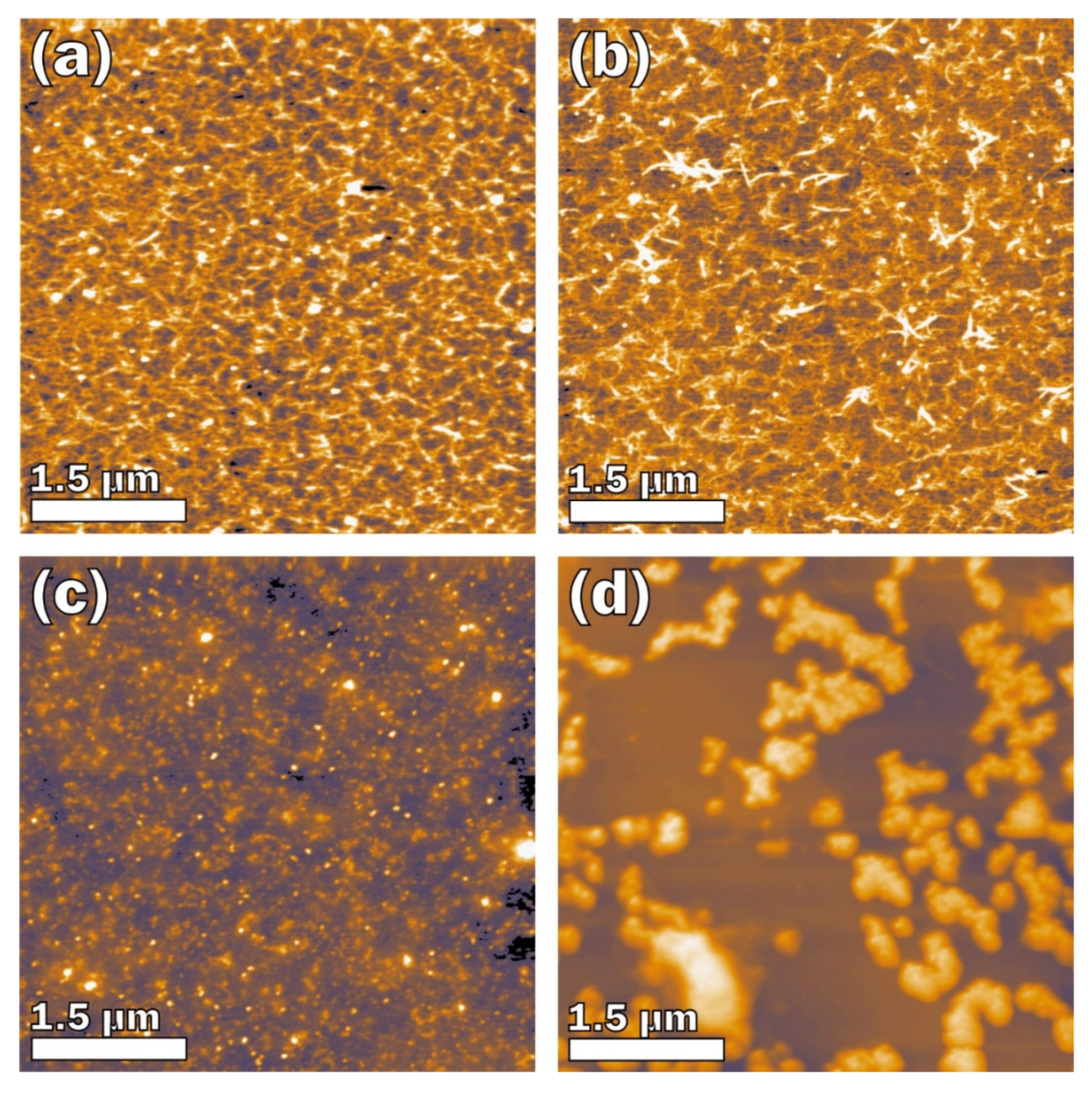
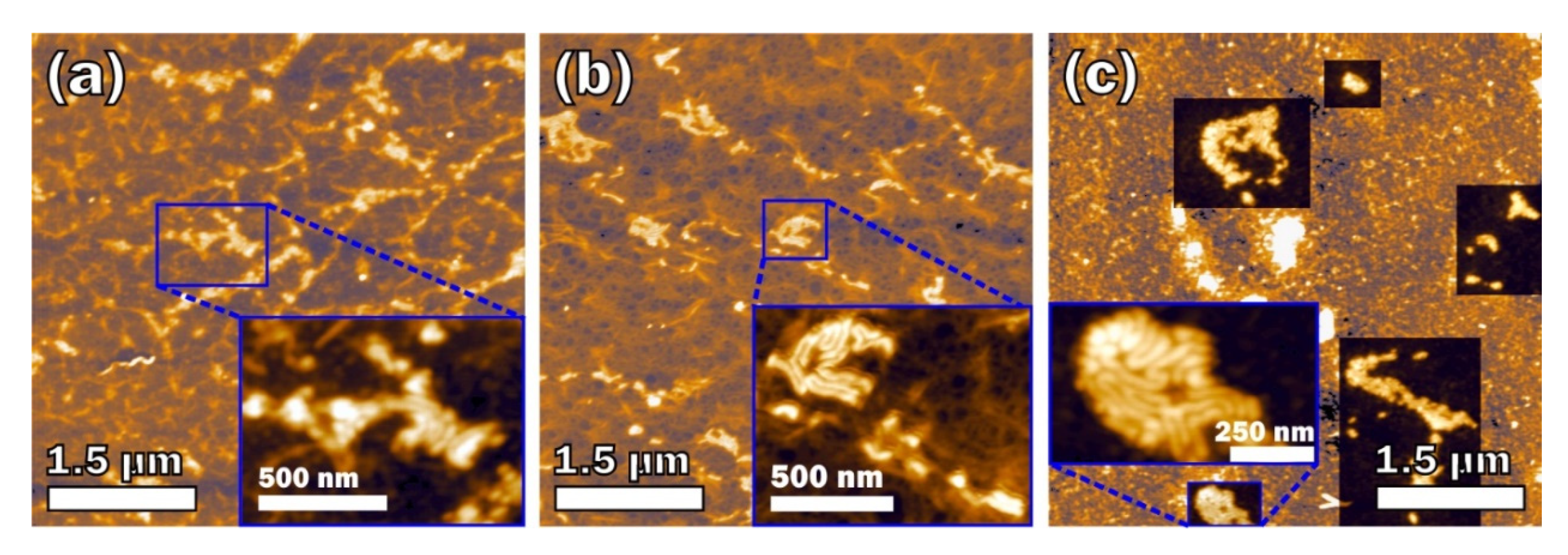
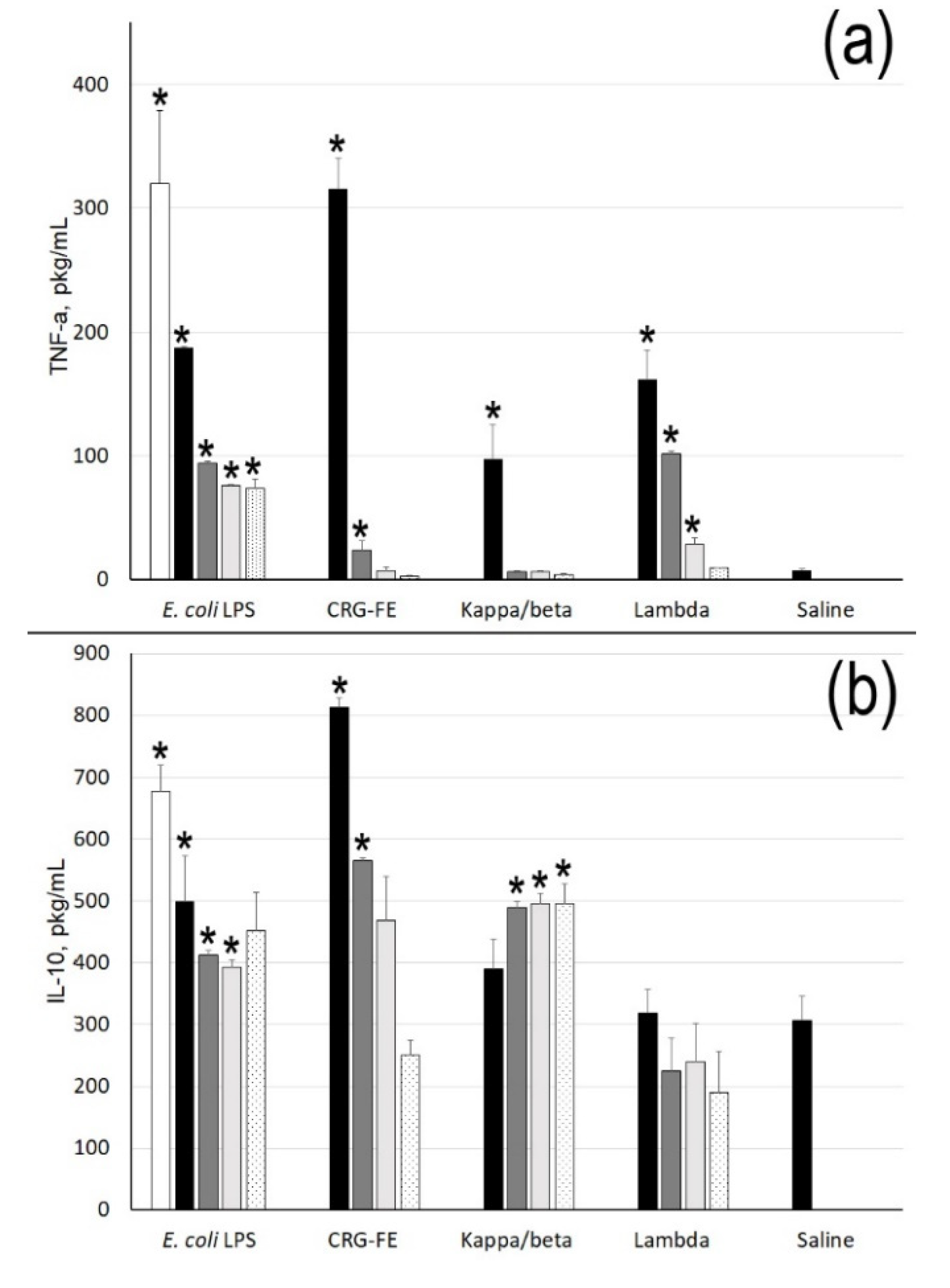
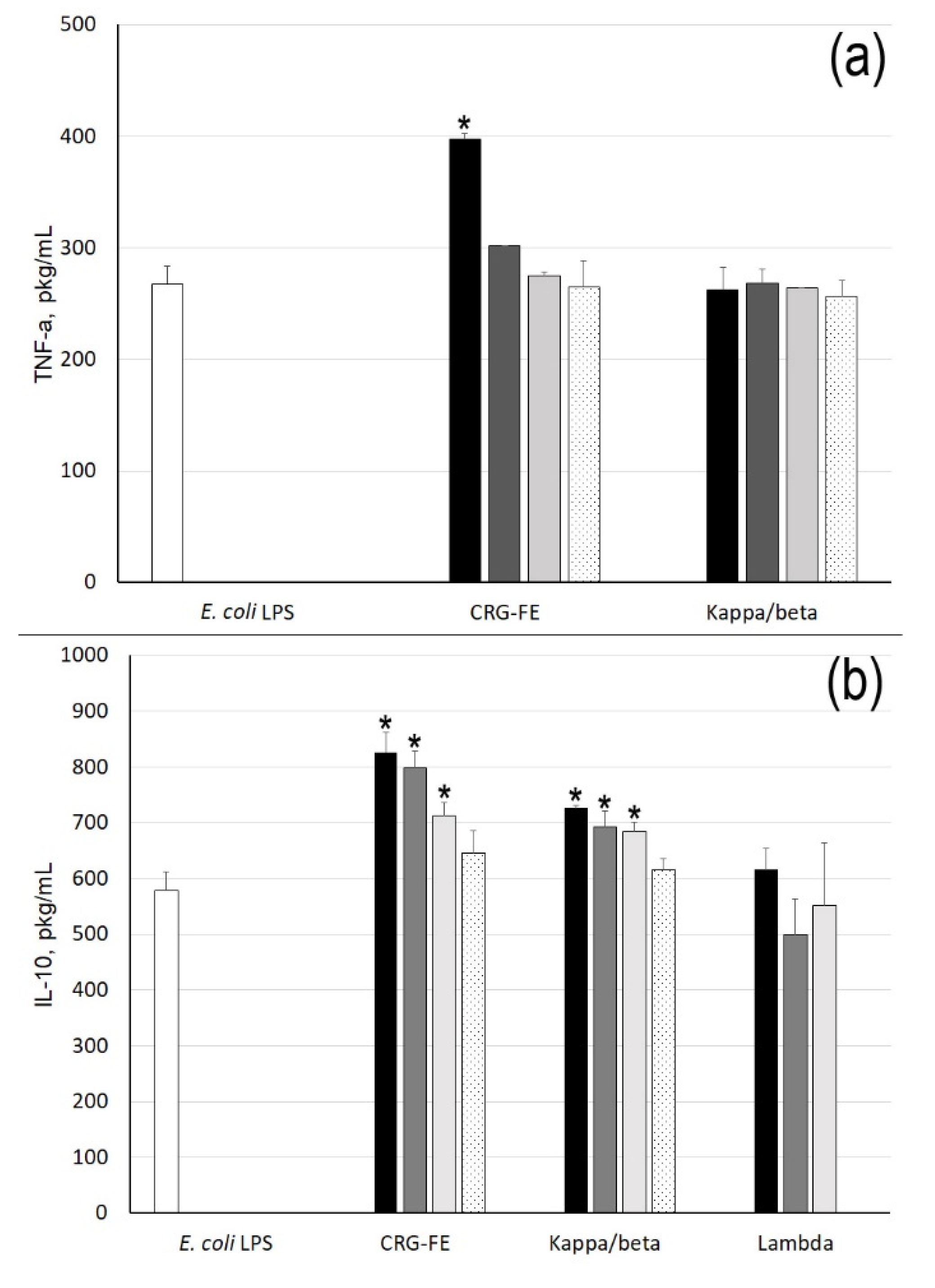
| Source of Carrageenans | Type of CRG | Structure of Disaccharide Repeating Unit | Mw, kDa |
|---|---|---|---|
| C. armatus Gigartinaceae | Kappa (κ) |  | 560 |
| Lambda (λ) | 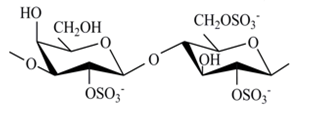 | 185 | |
| T. crinitus Tichocarpaceae | Kappa/beta (κ/β) (60:40) |  | 172 |
| Groups | Relative Organ Masses, mg/g BM | |||
| Liver | Thymus | Thyroid | Adrenals | |
| control | 54.16 ± 6.60 | 1.98 ± 0.22 | 0.175 ± 0.016 | 0.217 ± 0.018 |
| LPS | 62.79 ± 7.83 a | 1.27 ± 0.16 a | 0.138 ± 0.018 a | 0.282 ± 0.032 a |
| LPS + ∑-CRG. | 60.06 ± 4.77 | 1.55 ± 0.12 b | 0.157 ± 0.013 b | 0.243 ± 0.033 b |
| LPS + κ/β-CRG | 61.48 ± 5.74 | 1.67 ± 0.16 b | 0.162 ± 0.017 b | 0.228 ± 0.031 b |
| LPS + κ-CRG | 55.25 ± 5.85 b | 1.43 ± 0.22 | 0.148 ± 0.039 | 0.254 ± 0.014 b |
| LPS + λ-CRG | 60.14 ± 4.96 | 1.29 ± 0.17 | 0.153 ± 0.032 | 0.265 ± 0.029 |
| Biochemical parameters | ||||
| Groups | Serum corticosterone, μmol/L | Liver ATP, μmol/g | Liver lactate, μmol/g | Liver glycogen, μmol/g |
| control | 0.28 ± 0.043 | 2.72 ± 0.222 | 1.88 ± 0.443 | 232.6 ± 43.89 |
| LPS | 0.39 ± 0.047 a | 2.00 ± 0.377 a | 2.53 ± 0.350 a | 176.6 ± 17.33 a |
| LPS + ∑-CRG | 0.30 ± 0.047 b | 2.45 ± 0.337 b | 2.10 ± 0.395 b | 220.4 ± 41.04 b |
| LPS + κ/β-CRG | 0.30 ± 0.071 b | 2.31 ± 0.140 b | 2.21 ± 0.217 b | 210.6 ± 20.46 b |
| LPS + κ-CRG | 0.33 ± 0.080 | 2.52 ± 0.338 b | 2.44 ± 0.308 | 230.8 ± 30.22 b |
| LPS + λ-CRG | 0.38 ± 0.047 | 2.06 ± 0.076 | 2.60 ± 0.359 | 185.6 ± 35.82 |
| Indicator | On Admission to the Hospital N = 42 | 3- Days of Therapy | Control N = 20 | ||
|---|---|---|---|---|---|
| With CRG-FE N = 22 | Without CRG-FE N = 20 | ||||
| Leukocytes * 109/L, abs | 8.3 ± 3.3 | 6.6 ± 2.9 †‡ | 5.7 ± 1.8 | 6.45 ± 1.5 | |
| neutrophils, | % | 81.4 ± 8.5 * | 60.8 ± 8.9 ‡ | 67.8 ± 5.7 | 62.5 ± 11.4 |
| abs × 109/L | 6.8 ± 3.2 * | 4.2 ± 2.7 ‡ | 3.9 ± 1.3 | 4.12 ± 1.6 | |
| lymphocytes | % | 13.7 ± 6.9 * | 31.5 ± 7.5 †‡ | 26 ± 5.4 * | 34.0 ± 10.6 |
| abs × 109/L | 1.0 ± 0.4 * | 2.0 ± 0.7 †‡ | 1.4 ± 0.3 * | 2.1 ± 0.6 | |
| CD3+ | % | 66.4 ± 8.4 | 73.5 ± 7.4 ‡ | 74.2 ± 5.2 | 68.7 ± 7.3 |
| abs × 109/L | 0.7 ± 0.3 * | 1.4 ± 0.5 †‡ | 1.0 ± 0.2 * | 1.42 ± 0.3 | |
| CD4+ | % | 43.0 ± 20.0 | 45.7 ± 7.4 | 49.8 ± 4.1 * | 40.0 ± 17.0 |
| abs × 109/L | 0. 5 ± 0.2 * | 0.9 ± 0.3 ‡ | 0.76 ± 0.2 | 0.81 ± 0.1 | |
| CD8+ | % | 22.3 ± 14.5 | 24.5 ± 6.4 | 22.8 ± 5.2 | 25.6 ± 6.0 |
| abs × 109/L | 0.3 ± 0.1 * | 0.5 ± 0.2 | 0.4 ± 0.2 | 0.6 ± 0.2 | |
| CD4+/CD8+ | 2.2 (0.4–4.8) | 2.0 (0.9–3.6) | 2.4 (1.5–3.4) | 1.6 (1.1–2.5) | |
| CD 19 % | % | 15.4 ± 5.1 | 11.7 ± 3.4 ‡ | 10.9 ± 4.0 | 12.4 ± 3.5 |
| abs × 109/L | 0.2 ± 0.1 * | 0.2 ± 0.1 †‡ | 0.2 ± 0.1 * | 0.3 ± 0.1 | |
© 2020 by the authors. Licensee MDPI, Basel, Switzerland. This article is an open access article distributed under the terms and conditions of the Creative Commons Attribution (CC BY) license (http://creativecommons.org/licenses/by/4.0/).
Share and Cite
Yermak, I.M.; Volod’ko, A.V.; Khasina, E.I.; Davydova, V.N.; Chusovitin, E.A.; Goroshko, D.L.; Kravchenko, A.O.; Solov’eva, T.F.; Maleev, V.V. Inhibitory Effects of Carrageenans on Endotoxin-Induced Inflammation. Mar. Drugs 2020, 18, 248. https://doi.org/10.3390/md18050248
Yermak IM, Volod’ko AV, Khasina EI, Davydova VN, Chusovitin EA, Goroshko DL, Kravchenko AO, Solov’eva TF, Maleev VV. Inhibitory Effects of Carrageenans on Endotoxin-Induced Inflammation. Marine Drugs. 2020; 18(5):248. https://doi.org/10.3390/md18050248
Chicago/Turabian StyleYermak, Irina M., Aleksandra V. Volod’ko, Eleonora I. Khasina, Viktoriya N. Davydova, Evgeniy A. Chusovitin, Dmitry L. Goroshko, Anna O. Kravchenko, Tamara F. Solov’eva, and Victor V. Maleev. 2020. "Inhibitory Effects of Carrageenans on Endotoxin-Induced Inflammation" Marine Drugs 18, no. 5: 248. https://doi.org/10.3390/md18050248
APA StyleYermak, I. M., Volod’ko, A. V., Khasina, E. I., Davydova, V. N., Chusovitin, E. A., Goroshko, D. L., Kravchenko, A. O., Solov’eva, T. F., & Maleev, V. V. (2020). Inhibitory Effects of Carrageenans on Endotoxin-Induced Inflammation. Marine Drugs, 18(5), 248. https://doi.org/10.3390/md18050248





